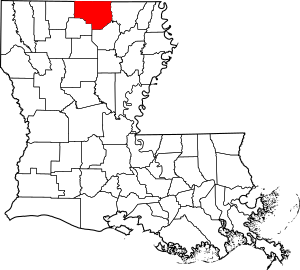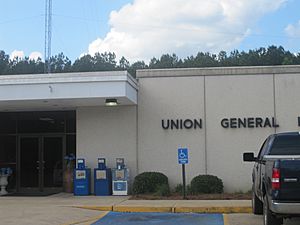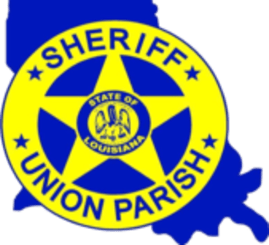Union Parish, Louisiana facts for kids
Quick facts for kids
Union Parish, Louisiana
|
|
|---|---|
| Parish of Union | |

Union Parish Courthouse in Farmerville
|
|

Location within the U.S. state of Louisiana
|
|

Louisiana's location within the U.S.
|
|
| Country | |
| State | |
| Region | North Louisiana |
| Founded | March 13, 1839 |
| Named for | Union of American states |
| Parish seat (and largest town) | Farmerville |
| Area | |
| • Total | 2,340 km2 (905 sq mi) |
| • Land | 2,270 km2 (877 sq mi) |
| • Water | 70 km2 (28 sq mi) |
| • percentage | 7.9 km2 (3.06 sq mi) |
| Population
(2020)
|
|
| • Total | 21,107 |
| • Density | 9.005/km2 (23.323/sq mi) |
| Time zone | UTC-6 (CST) |
| • Summer (DST) | UTC-5 (CDT) |
| Area code | 318 |
| Congressional district | 4th |

Union Parish is a special kind of county in Louisiana. It's located in the north-central part of the state. In 2020, about 21,107 people lived there. The main town and "parish seat" is Farmerville.
Union Parish was created on March 13, 1839. It was formed from a part of Ouachita Parish. Its borders have changed a few times since then. Union Parish is also part of the larger Monroe area.
Contents
Exploring Union Parish: Location and Landscape
Union Parish is in north-central Louisiana. It shares many cultural and educational ties with Lincoln Parish, which is to its southwest. Union Parish, along with Lincoln Parish and Union County in Arkansas, forms the eastern edge of the Ark-La-Tex region.
How Big is Union Parish?
Union Parish covers a total area of about 905 square miles. Most of this is land (877 square miles). About 28 square miles, or 3.1%, is water.
Main Roads in Union Parish
If you're traveling through Union Parish, you might use these important roads:
Neighboring Areas
Union Parish is surrounded by other parishes and counties:
- Union County, Arkansas (to the north)
- Ashley County, Arkansas (to the northeast)
- Morehouse Parish (to the east)
- Ouachita Parish (to the southeast)
- Lincoln Parish (to the southwest)
- Claiborne Parish (to the west)
Protected Natural Areas
Parts of two national wildlife refuges are found in Union Parish:
Towns and Villages in Union Parish
Union Parish has several communities, from larger towns to smaller villages and unincorporated areas.
Towns
- Bernice
- Farmerville (This is the main town and the largest one.)
- Marion
Villages
Unincorporated Communities
These are smaller areas that are not officially towns or villages:
- Alabama Landing
- Oakland
- Ouachita City
- Point
- Shiloh
- Truxno
Who Lives in Union Parish?
| Historical population | |||
|---|---|---|---|
| Census | Pop. | %± | |
| 1840 | 1,838 | — | |
| 1850 | 8,203 | 346.3% | |
| 1860 | 10,389 | 26.6% | |
| 1870 | 11,685 | 12.5% | |
| 1880 | 13,526 | 15.8% | |
| 1890 | 17,304 | 27.9% | |
| 1900 | 18,520 | 7.0% | |
| 1910 | 20,451 | 10.4% | |
| 1920 | 19,621 | −4.1% | |
| 1930 | 20,731 | 5.7% | |
| 1940 | 20,943 | 1.0% | |
| 1950 | 19,141 | −8.6% | |
| 1960 | 17,624 | −7.9% | |
| 1970 | 18,447 | 4.7% | |
| 1980 | 21,167 | 14.7% | |
| 1990 | 20,690 | −2.3% | |
| 2000 | 22,803 | 10.2% | |
| 2010 | 22,721 | −0.4% | |
| 2020 | 21,107 | −7.1% | |
| U.S. Decennial Census 1790-1960 1900-1990 1990-2000 2010 |
|||
In 2020, the population of Union Parish was 21,107 people. There were 7,582 households and 4,899 families living in the parish.
Education in Union Parish
Students in Union Parish attend schools that are part of the Union Parish Public Schools system.
Law Enforcement in Union Parish
| Union Parish Sheriff's Office | |
|---|---|
| Abbreviation | UPSO |
| Motto | Service Before Self |
| Agency overview | |
| Formed | 1839 |
| Jurisdictional structure | |
| General nature | |
| Operational structure | |
| Headquarters | Farmerville, Louisiana |
| Agency executive |
|
| Website | |
| http://www.unionsheriff.com/ | |
The Union Parish Sheriff's Office is the main law enforcement group in Union Parish. Their headquarters are in Farmerville. The current Sheriff is Dusty Gates. He became Sheriff in 2013 after the previous Sheriff, Bob Buckley, passed away.
Border Monument
In 1931, a special monument was put up where Union Parish meets Union County, Arkansas. Later, in 1975, a state representative named Louise B. Johnson helped pass a law to fix up the monument. The newly restored monument was shown to the public in 2009.
Famous People from Union Parish
Many important people have come from Union Parish, including governors of Louisiana and Arkansas.
Governors of Louisiana
Two governors of Louisiana were from the Shiloh Community in Union Parish:
- William Wright Heard, who was governor from 1900 to 1904.
- Ruffin Pleasant, who was governor from 1916 to 1920.
Governors of Arkansas
Two governors of Arkansas were born in Union Parish:
- George Washington Donaghey, who was Governor of Arkansas from 1909 to 1913.
- Tom Jefferson Terral, who was Governor of Arkansas from 1925 to 1927.
Other Notable Residents
Other well-known people from Union Parish include:
- Lonnie O. Aulds, a state representative from 1968 to 1972.
- George Washington Bolton (1841-1931), a state representative from 1888 to 1896.
- Jay McCallum, who is a Chief Judge for the Louisiana 3rd Judicial District Court.
- Robert Roberts Jr., a state representative and state district judge.
- James Peyton Smith, a state representative.
- Lee Emmett Thomas, who was the Speaker of the Louisiana House of Representatives.
See also
 In Spanish: Parroquia de Union para niños
In Spanish: Parroquia de Union para niños



